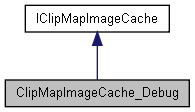ClipMapImageCache_Debug Class Reference#include <clipMapDebugCache.h>
Inheritance diagram for ClipMapImageCache_Debug:  Detailed DescriptionA clipmap "cache" that produces a variety of debug patterns on the fly.This is very useful for debugging the clipmap shaders as well as visualizing various parts of the clipmap process (LOD selection, cache centering behavior, etc.).
Member Enumeration Documentation
Constructor & Destructor Documentation
Member Function Documentation
Initialize the image cache that can hold at least clipMapSize*clipMapSize pixels of data. In general the image cache will allocate a bit more than that so it can be efficient in pre-empting requests. The image cache will also store mipmap data for the interest point, at least clipMapSize px at each miplevel. e.g., for a parameter of 512, we would have available in the cache at all times 512*512*clipMapDepth pixels. Ideally, we would ensure at least one page quanta's worth of extra data is present at all levels so we can fulfill new data requests quickly. For instance, if we have 128px paged tiles, we'd want to have at least 512/128 = 4 base tiles and 2 border tiles on each axis, so 36 loaded tiles at all times at the source level of detail. This is about two and a quarter megabytes of data per clipmap level, so a cache of about 7 levels * 2.25mb = 15.75mb in system memory for a 32k px source texture. We don't need any "mip" levels - just pure source data for every cliplevel greater than or equal to the clipmap size. As we may need to regenerate the full clipmap in the case of zombification, we can't discard the top level of data, even though it is never needed in the course of normal clipmap operation. Implements IClipMapImageCache.
Indicate our interest area center. The cache is for a fixed size area, so we disallow changing that area size. Implements IClipMapImageCache.
Indicate that we are going to be updating a series of rectangles on specified level of the clipstack.
Implements IClipMapImageCache.
This is the only place that does any real work - it copies the debug pattern.
Implements IClipMapImageCache.
And finally, give the cache a chance to finish processing for a specified clipstack level.
Implements IClipMapImageCache.
If true, we'll allocate render targets rather than normal diffuse maps.
Implements IClipMapImageCache.
Member Data Documentation
One of DebugModes.
Render alternating 4px squares on top of the debug mode.
|
||||||||||||||||||||||||||||||||||||||||||||||||||||||||||||||||||||||||||||||||||||||||||||||||||||||||||||||||||||||||||||||||||||||||||||||||||||||